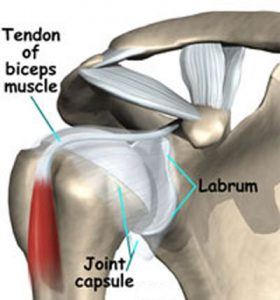Shoulder Labral Tear

A shoulder labral tear is an injury to the cartilage in the shoulder joint. The shoulder is a ball and socket joint. The ball is the end of the arm bone (humerus). This ball fits into the bowl-shaped socket of the shoulder (glenoid). Cartilage lines the socket to keep movement smooth. When the cartilage tears it is called a shoulder labral tear. More importantly, the major ligaments that stabilize the shoulder attach to the labrum. Therefore, tears of the labrum usually result in tearing or “stretching” of the ligaments.
Symptoms
If you have any of these symptoms do not assume it is due to a labral tear. They may be caused by other conditions. Tell your doctor if you have any of these:
- Shoulder and/or arm pain
- Catching or loosening feeling of shoulder
- Loss of shoulder range of motion
- Weakness to shoulder and/or arm
- Pain with shoulder movement- especially throwing activities.
- Popping or grinding sensation
- Achiness to shoulder
Causes
- Repetitive overhead activities (i.e. throwing, tennis)
- Shoulder dislocations (subluxations)
Treatment
Talk with your doctor about the best treatment plan for you. Treatment options include the following:
Medical Treatment
- Nonsteroidal anti-inflammatory drugs (NSAIDs)
- Rest, heat, and/or ice
- Physical therapy to strengthen muscles and stretch the capsule
Generally this treatment is tried for several weeks. If there is no improvement, surgery is considered. Your doctor may also inject a steroid directly into your shoulder to decrease inflammation and pain.
Surgical Treatment – Arthroscopic Surgery
In a shoulder arthroscopy, your surgeon inserts a thin, lighted tube through a small incision to view the injury and fix it. Small instruments are threaded through this tube. The torn cartilage may be removed or sewn together. Your surgeon may also use anchors and stitches to reattach any torn tendons
Surgical Treatment – Open Surgery
The doctor will make a cut in the skin extending from below your collarbone to the armpit. The labrum will be repaired and reattached and/or anchored with stitches. The ligaments will be tightened as well.
Rehabilitation
After surgery, you will be given a sling to wear for three to four weeks. Once the sling is removed you will work with a physical therapist to gradually strengthen your arm muscles and increase your motion.
Shoulder Joint



